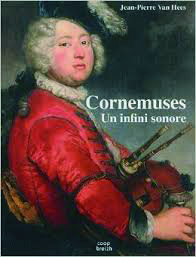The Bagpipe Society
Review - Un infini sonore by Jean-Pierre Van Hees

Coop Breizh, ISBN 978-2-84346-637-3
There are a number things that hit you when you first see this book – that it’s big, heavy, sumptuous, glossy, richly illustrated – and in French. But don’t let this last fact put you off. Yes, of course, it helps if you can understand French but even if you can’t, I still think this wonderful book has something to offer anyone who loves and appreciates bagpipes.
At the cost of about £50.00, I hesitated for some time about buying it but I’m so glad I did and I think it was worth every penny. It is a beautifully produced book with clear photographs and it also contains 2 DVDs.
In this book the author, Jean-Pierre Van Hees, has set out to classify, describe and record all the known types of bagpipe across all cultures. The book is broken down into distinct sections. The first shows the constituent parts of a bagpipe, describing and illustrating all the different types of chanter, drones, bags, blowpipes, stocks, reeds and bellows which can be found on pipes. This is followed by a photographic catalogue of all the main types of bagpipes and a map showing their location of origin. Next is the history and evolution of the instrument from antiquity through to the 21th century. There are almost as many pictures in this section as there are words, so no need to worry about not understanding the text.
The book contains a bagpipe tutorial for both G-bagpipes and the Baroque Musette and this chapter is backed up by an accompanying DVD illustrating the various lessons and techniques. In case you’re wondering why the baroque musette - as it isn’t the obvious choice for a tutorial - Van Hees is a renowned performer of this instrument.
The chapter titled, Bagpipes and Western Music, is more text based and does require knowledge of French to fully appreciate it but having said that, it is again illustrated with many musical examples. The musical development of the bagpipe is shown from the medieval period up to the modern day.
More illustrations appear in a chapter showing how bagpipes themselves have become works of art and there are depictions of some of the elaborate carving and decoration that can found on some instruments. Following this, is a section on how bagpipes have appeared in art over the centuries and then, the last chapter looks at some of the myths and clichés that have built up about the instrument over the years. Finally, there is, as you would expect of a work such as this, an extensive bibliography, together with a discography.
As though that is not enough, there is the second DVD which consists of video clips of 150 different types of bagpipe being played. Some of the clips are a bit ‘clinical’ but there are a few gems hidden amongst them. Just fantastic.
I can’t recommend this book highly enough. It can be bought via Amazon in the UK or direct from the publishers, Coop Breizh, in France.
Jane Moulder
From Chanter Spring 2015.
- Data Processing Notice (GDPR)
-
@BagpipeSociety on X (formally known as Twitter)
-
TheBagpipeSociety on Instagram
-
 BagpipeSociety on Facebook
BagpipeSociety on Facebook
Something wrong or missing from this page? Let us know!
